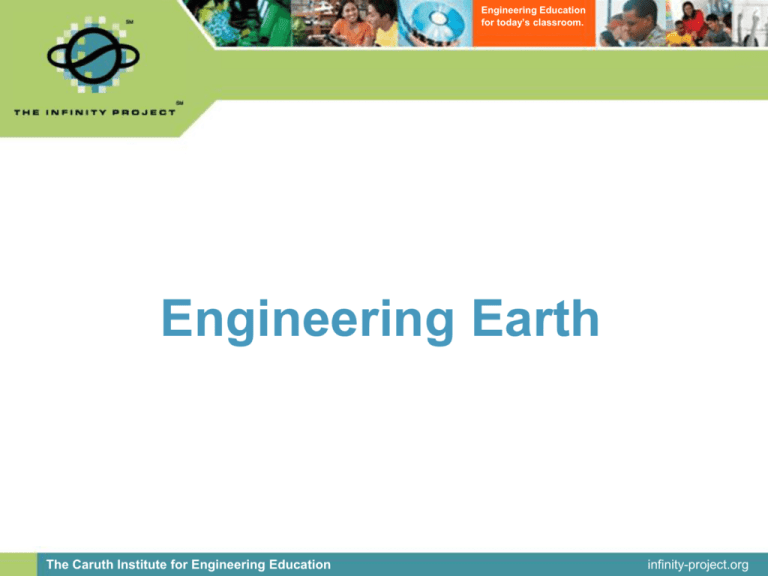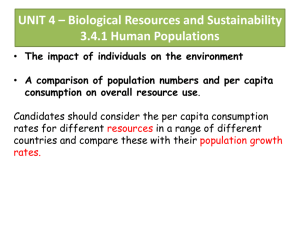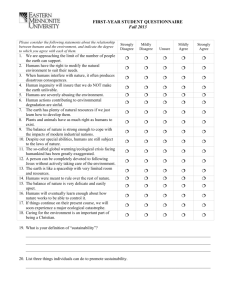Environmental Engineering and Sustainability PowerPoint
advertisement

Engineering Education for today’s classroom. Engineering Earth The Caruth Institute for Engineering Education infinity-project.org Engineering Education for today’s classroom. Module Outline Unit 1: What Is Environmental Engineering? Section 1: What Does a Synthesis of Engineering and the Environment Look Like? Section 2: Sustainability—What Is It, and Why Is It Important? Unit 2: Water and the Environment Section 1: Water and Watersheds Section 2: Water Quality and Water Monitoring Unit 3: Engineering for Sustainability Section 1: Technological Solutions Section 2: Ecological Solutions The Caruth Institute for Engineering Education infinity-project.org Engineering Education for today’s classroom. Unit 1: What Is Environmental Engineering? The Caruth Institute for Engineering Education infinity-project.org Engineering Education for today’s classroom. Unit 1: Objectives Students will learn about the discipline of environmental engineering and its unique aspects. Students will learn about sustainability and its relationship to the physical sciences. Students will discover how an ecological footprint is determined. The Caruth Institute for Engineering Education infinity-project.org Engineering Education for today’s classroom. Section 1: What Does a Synthesis of Engineering and the Environment Look Like? The Caruth Institute for Engineering Education infinity-project.org Engineering Education for today’s classroom. Environmental Engineering Is… What Is Engineering? Application of scientific principles to create tools, objects, and systems that accomplish specified objectives What Is Environmental Engineering? Application of scientific principles to: Improve the environment Support human needs Address human-induced effects on ecosystems The Caruth Institute for Engineering Education infinity-project.org Engineering Education for today’s classroom. Environmental Engineering Is Also… An Opportunity to Partner with Nature Solutions benefit humans as well as nature. Connected to Other Disciplines Environmental engineers require knowledge of physical sciences as well as applied sciences. Solutions have to take into account: Local history and customs The availability of resources Previous scientific studies and research The decision-making process The Caruth Institute for Engineering Education infinity-project.org Engineering Education for today’s classroom. Environmental Engineers Do... Pollution Control Prevention, reduction, and cleanup Impact Assessment Determining the impact of human activities on the environment Watershed Management Balancing nature’s requirements with human water needs Waste Treatment & Storage Treatment of waste returning to the environment; storage if not The Caruth Institute for Engineering Education infinity-project.org Engineering Education for today’s classroom. Activity 1.1 Environmental Engineering Inventory Activity 1.1 List common examples of environmental engineering that you have encountered in your everyday life. What scientific principles are behind them? Can you think of a better means to accomplish the same goals? The Caruth Institute for Engineering Education infinity-project.org Engineering Education for today’s classroom. Section 2: Sustainability—What Is It, and Why Is It Important? The Caruth Institute for Engineering Education infinity-project.org Engineering Education for today’s classroom. Introduction to Sustainability Sustainability is based on physical laws. Conservation of mass Conservation of energy Resource availability Working definition: “the ability of a process or activity to continue indefinitely without outside intervention” Example: an ecosystem in balance with its local environment Ecosystem is altered by environmental changes Becomes unsustainable if changes are too dramatic The Caruth Institute for Engineering Education infinity-project.org Engineering Education for today’s classroom. Activity 1.2 StarLogo TNG Food Web Simulation Activity 1.2 Because of the sheer scale and number of organisms in most ecosystems, gaining a direct appreciation of the interrelationships can be difficult. Using this food web simulation for StarLogo TNG, investigate the relationships between solar energy, biomass, and the population sizes of primary producers, herbivores, and carnivores. The Caruth Institute for Engineering Education infinity-project.org Engineering Education for today’s classroom. Nutrient Cycles Critical Elements for Living Systems Most critical: carbon, hydrogen, oxygen, nitrogen, and phosphorus Can you think of elements not on this list? Nutrient Cycles Recycle Limited Resources Reliant on the balance of organisms in a given ecosystem Subject to change in the relative abundances of the forms of each element, although the total amount remains constant The Caruth Institute for Engineering Education infinity-project.org Engineering Education for today’s classroom. The Water Cycle Most Visible and Familiar Cycle Involves all three forms of water Subterranean component is as critical to human water use as the visible portion. Extreme disruption or absence of surface water manifests as desertification. The Caruth Institute for Engineering Education infinity-project.org Engineering Education for today’s classroom. The Carbon Cycle One of the Most Discussed and Human-Influenced Cycles Essential element in biological molecules Both land- and sea-based ecosystems contribute to the cycle. Significant amounts are sequestered below the surface as fossil fuels. The Caruth Institute for Engineering Education infinity-project.org Engineering Education for today’s classroom. The Nitrogen Cycle Reliant on Bacterial and Plant Activity Atmospheric nitrogen, N2, is not accessible to most organisms. Nitrogen-fixing bacteria convert N2 to nitrates and ammonia. Nitrogen is a component of proteins, and low availability can limit plant growth. The Caruth Institute for Engineering Education infinity-project.org Engineering Education for today’s classroom. Combined Cycles Cycles Interact and Influence One Another Water Part of its own cycle Part of the oxygen cycle Acts to weather rocks, which helps drive the phosphorus cycle Carbon Changes in CO2 levels can affect surface water availability. The Caruth Institute for Engineering Education infinity-project.org Engineering Education for today’s classroom. Ecological Footprint What Is an Ecological Footprint? A method of estimating the impacts of human activity on the biosphere Measures environmental resources required for creating and distributing a specific product or service Land area Carbon sequestration ratio Energy to produce and transport the product or service Waste The Caruth Institute for Engineering Education infinity-project.org Engineering Education for today’s classroom. World Ecological Footprint Ecological footprint calculation includes transportation costs, which are higher in countries importing large quantities of goods. The per capita income level also serves as a strong indicator of consumption. The Caruth Institute for Engineering Education infinity-project.org Engineering Education for today’s classroom. Activity 1.3 What’s Your Ecological Footprint? Activity 1.3 Use the ecological footprint calculator on the Global Footprint Network Web site to determine the ecological impact of the class. The Caruth Institute for Engineering Education infinity-project.org Engineering Education for today’s classroom. How Do We Achieve Sustainability? Two Examples Recycling Acquiring and processing raw materials uses more energy than recycling existing products. Recycling reduces waste. Ecosystem Services Many of the tasks we perform using technology can instead be performed using natural systems. Examples: water filtration, erosion control, and chemical cleanup The Caruth Institute for Engineering Education infinity-project.org Engineering Education for today’s classroom. Waste Disposal Sustainability The Caruth Institute for Engineering Education infinity-project.org Engineering Education for today’s classroom. Exercise 1.1 Sustainability Inventory Exercise 1.1 All communities have resources that can be used to address the sustainability challenges that lie ahead. Make a thematic map of the environmental assets in your community and the problems they could help address. The Caruth Institute for Engineering Education infinity-project.org Engineering Education for today’s classroom. Unit 1: Wrap-up Environmental engineering employs a wide variety of skills and addresses a diverse set of problems. Sustainability requires energy and resource use to be in balance with energy and resource availability. An ecological footprint calculates the environmental costs associated with human activities. The Caruth Institute for Engineering Education infinity-project.org




